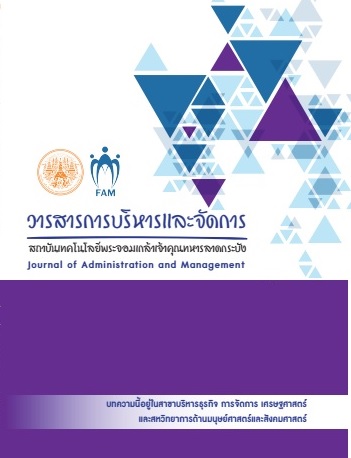Factors Affecting Service Quality of Digital Terrestrial Television (DTTV) Services in Thailand
Main Article Content
Abstract
Digital Terrestrial Television (DTTV) Services in Thailand have many benefits to Thai viewers compared to analog televisions. In 2012, National Broadcasting and Telecommunication Commission introduced DTTV in Thailand. The rates of DTTV adoption in Thailand have been slow because of some problems with terrestrial television services. The objective of this study is to examine and understand three main group factors that contribute to digital terrestrial television services quality such as the personal background of viewers, hardware receiver quality, and the variable location of the stations to transmit. There is an independent variable in the model which is the rating of signal quality by the viewer’s satisfaction. A sample survey conducted with questionnaires by collect data from 4,075 Thai viewers who have watched digital television. Using such data, the researcher estimated service quality by applying multiple regression analysis to determine essential factors, and measure their significance, and the results of the study showed that six variables were critical factors that have an impact on viewer satisfaction. The effect of the study will help policymakers to understand Thai TV viewers, and provide suggestions on how to promote efficient DTTV service quality strategies.
Article Details
Journal of KMITL Business School is available both online and in printed version.
**All articles or opinions presented in this issue of the Journal of KMITL Business School reflect the thoughts of their respective authors. This journal serves as an independent platform for a variety of viewpoints. Authors bear full responsibility for the content of their articles.**
**All articles published in this journal are copyrighted by KMITL Business School, King Mongkut's Institute of Technology Ladkrabang. The editorial team permits copying or using articles, but a reference to the journal is required.**
References
ปรมะ สตะเวทิน. (2541). หลักนิเทศศาสตร์. กรุงเทพมหานคร: รุ่งเรืองสาส์นการพิมพ์.
ระพี สาคริก. (2558). นวัตกรรมเทคโนโลยีการศึกษา: สื่อมวลชนกับการพัฒนาสังคม. สืบค้นเมื่อ 4 กันยายน 2558.จากhttp://www. 53010516043.blogspot.com/2012/09/blog-post_4898.html
สุรพงษ์ โสธนะเสถียร. (2533). แนวคิดและทฤษฎีเกี่ยวกับความรู้ ทัศนคติ และพฤติกรรม. สืบค้นเมื่อ 4 ตุลาคม 2558. จากhttp://www.udru.ac.th/~boonpan/ 1031204/Mass02.html.
Atkin, Charles K. (1973). Anticipated communication and Mass Media Information Seeking. New. York: Free Press.
Becker, L. Samuel. 1972. Discovering Mass Communication. Illinois : Scott Foresman and Company Glenview.
Bitner, M.J. (1992), Servicescapes: The Impact of Physical Surroundings on Customers and Employees, Journal of Marketing. 56, 57-71.
Parasuraman, A., Zeithaml, V., and Berry, L. (1985). A Conceptual Model of Service Quality and its Implications for Future Research. The Journal of Marketing. 49, 41-50.


